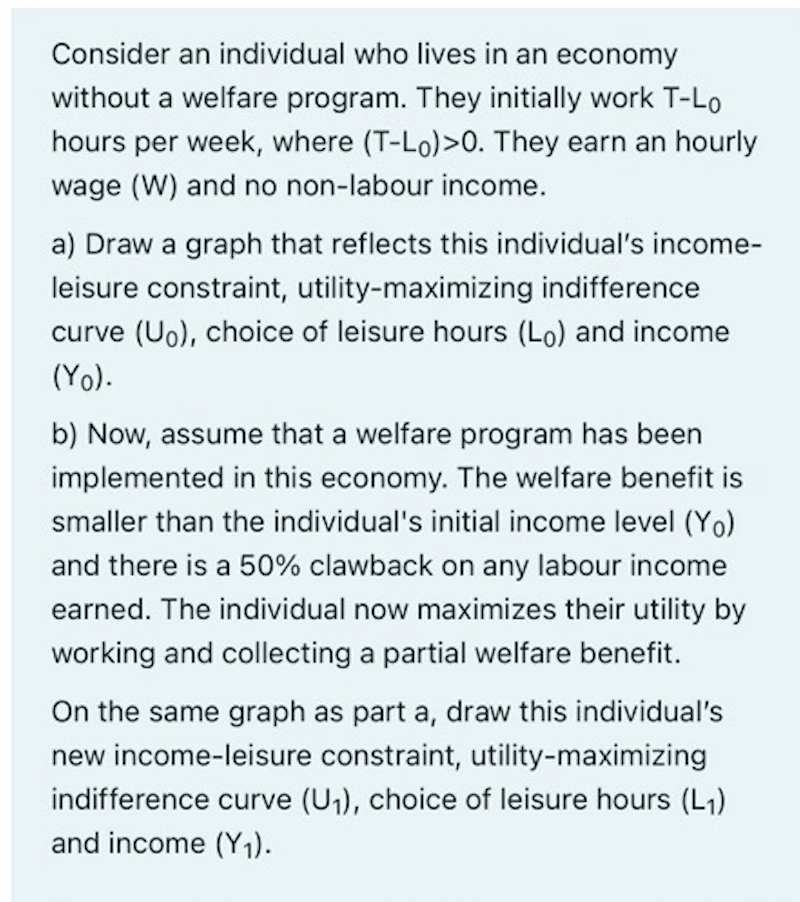Consider an individual who lives in an economy without a welfare program. They initially work T-Lo hours per week, where (T-Lo)>0. They earn an hourly wage (W) and no non-labour income. a) Draw a graph that reflects this individual's income- leisure constraint, utility-maximizing indifference curve (Uo), choice of leisure hours (Lo) and income (Yo). b) Now, assume that a welfare program has been implemented in this economy. The welfare benefit is smaller than the individual's initial income level (Yo) and there is a 50% clawback on any labour income earned. The individual now maximizes their utility by working and collecting a partial welfare benefit. On the same graph as part a, draw this individual's new income-leisure constraint, utility-maximizing
Consider an individual who lives in an economy without a welfare program. They initially work T-Lo hours per week, where (T-Lo)>0. They earn an hourly wage (W) and no non-labour income. a) Draw a graph that reflects this individual's income- leisure constraint, utility-maximizing indifference curve (Uo), choice of leisure hours (Lo) and income (Yo). b) Now, assume that a welfare program has been implemented in this economy. The welfare benefit is smaller than the individual's initial income level (Yo) and there is a 50% clawback on any labour income earned. The individual now maximizes their utility by working and collecting a partial welfare benefit. On the same graph as part a, draw this individual's new income-leisure constraint, utility-maximizing
Chapter16: Labor Markets
Section: Chapter Questions
Problem 16.2P
Related questions
Question

Transcribed Image Text:Consider an individual who lives in an economy
without a welfare program. They initially work T-Lo
hours per week, where (T-Lo)>0. They earn an hourly
wage (W) and no non-labour income.
a) Draw a graph that reflects this individual's income-
leisure constraint, utility-maximizing indifference
curve (Uo), choice of leisure hours (Lo) and income
(Yo).
b) Now, assume that a welfare program has been
implemented in this economy. The welfare benefit is
smaller than the individual's initial income level (Yo)
and there is a 50% clawback on any labour income
earned. The individual now maximizes their utility by
working and collecting a partial welfare benefit.
On the same graph as part a, draw this individual's
new income-leisure constraint, utility-maximizing
indifference curve (U₁), choice of leisure hours (L₁)
and income (Y₁).
Expert Solution
This question has been solved!
Explore an expertly crafted, step-by-step solution for a thorough understanding of key concepts.
Step by step
Solved in 4 steps with 2 images

Knowledge Booster
Learn more about
Need a deep-dive on the concept behind this application? Look no further. Learn more about this topic, economics and related others by exploring similar questions and additional content below.Recommended textbooks for you


Economics Today and Tomorrow, Student Edition
Economics
ISBN:
9780078747663
Author:
McGraw-Hill
Publisher:
Glencoe/McGraw-Hill School Pub Co


Economics Today and Tomorrow, Student Edition
Economics
ISBN:
9780078747663
Author:
McGraw-Hill
Publisher:
Glencoe/McGraw-Hill School Pub Co